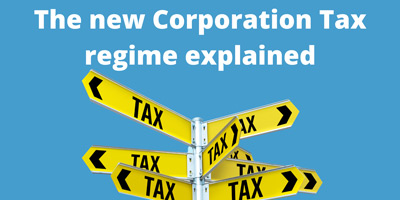
Michael Williams, of Knill James Tax Department, reflects on the reintroduction of a tiered system of Corporation Tax rates and reliefs, and considers how it will work in practice
Among the announcements in the March 2021 Budget was the increase in Corporation Tax to 25%, and the return of the small companies' rate (which will remain at 19%) and marginal relief. The changes will apply from 1 April 2023, with apportionment of taxable profits required where the accounting period straddles that date.
What level of profits will be affected by the higher rate of tax?
At the moment, there is one rate of Corporation Tax of 19% that applies to taxable profits made by all companies and this rate will continue to 31 March 2023. From 1 April 2023, the rate of Corporation Tax will rise to 25% where augmented profits exceed the lower limit of £50,000. Augmented profits are, broadly speaking, total taxable profits plus exempt non-group dividends received.
How will marginal relief work?
Marginal relief will be available where augmented profits do not exceed the upper limit of £250,000. The marginal relief provides for a gradually increasing rate of Corporation Tax from 19% to 25% on taxable profit amounts between the two limits. The way the calculation of the relief works, however, results in a marginal rate of tax of 26.5% on the taxable profit between £50,000 and £250,000.
The new associated companies rule
The limits of £50,000 and £250,000 will be pro-rated where the accounting period is shorter than 12 months, and also divided by the number of associated companies -plus the company itself -in the accounting period. Companies are defined as associated where one has control of the other, or both are under the control of the same person or persons.
It's important to note that it is not the same as the existing rule for dividing limits for Quarterly Instalment Payments (QIPs). This rule looks at 51% group companies only, and ignores companies held by the same shareholder that are not part of the same group of companies. The associated companies rule is broader, and companies under the control of the same shareholder(s) but not in the same group will have to be included.
The impact of the new rules on QIPs
As part of the Budget, it was also announced that the 51% group company rule for QIPs would be replaced by the associated companies rule for accounting periods commencing on or after 1 April 2023.
This change is likely to include more companies and hence lower the QIPs profit limits of £1.5m for large companies and £20m for very large companies further than under the current rule. The effect of this will be to make more companies come within, or become larger in, the QIPs regime and accelerate payments of Corporation Tax.
A return of the CICH rules
There is also the return of the Close Investment-Holding Company (CIHC) rules which tax close companies that, broadly, do not trade nor let land or property on a commercial basis at the main rate of 25% irrespective of profit levels.
A close company is one that five or fewer participators, or any number of participators if they are directors, have control of or are entitled to receive the majority of assets on a winding up. A participator includes a shareholder or loan creditor of the company, and relatives of the participators.
Holding companies which have subsidiaries that either trade or let land or property on a commercial basis will not be subject to the CIHC rules.
Tax planning implications for the allocation of losses
This makes the allocation of losses under the group relief regime, where available, more important and is something to consider from a tax planning perspective. Companies with profits subject to the higher marginal or main rate, or around the now lower QIPs limits, should be prioritised for receiving group and consortium relief surrenders to reduce the profits accordingly.
Any chargeable gains likely to be realised by companies in the next couple of years should, where possible, be accelerated. This is important to ensure they are taxed prior to the change in rules to obtain a lower rate and potentially delay payment of Corporation Tax.
The same… but different!
This may sound like a very familiar regime of Corporation Tax and that is because it is – the same rules were in effect up to the 2015 Financial Year. At this point, the main rate was reduced to be the same as the small profits rate and amalgamated into one single rate.
It should be no surprise considering the government's wish to raise tax revenues post-Covid that the main Corporation Tax rate of 25% will be the highest since the 2011 Financial Year. In addition, the limits for marginal relief are significantly lower than the £300,000 lower limit and £1.5m upper limit that were in force previously.
If you have any questions in regard to the changes, please contact Michael Williams on 01273 484934 or michaelw@knilljames.co.uk.